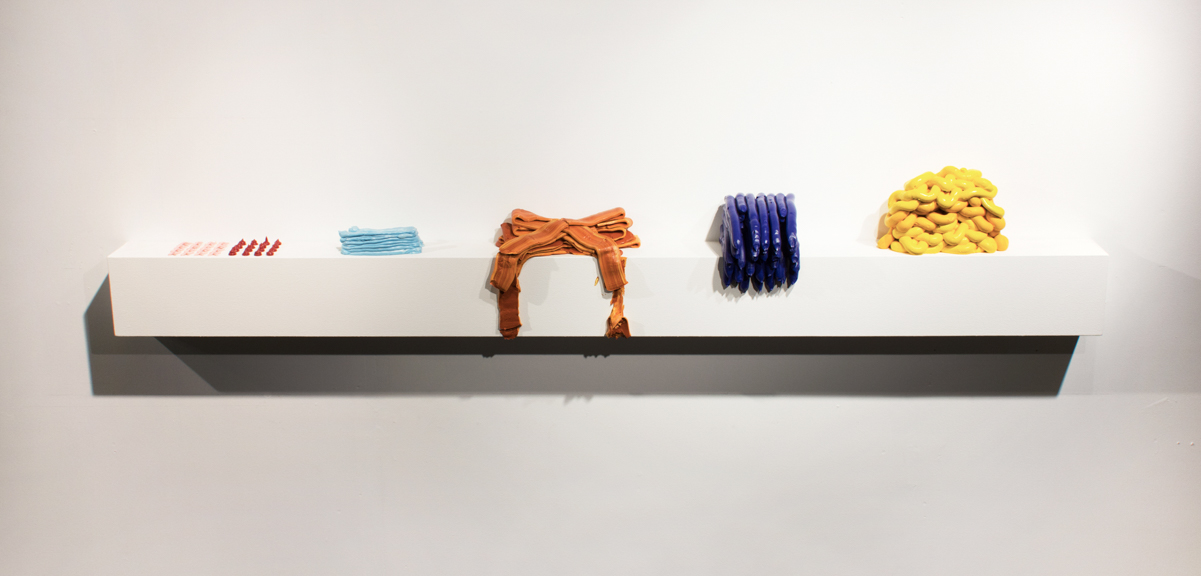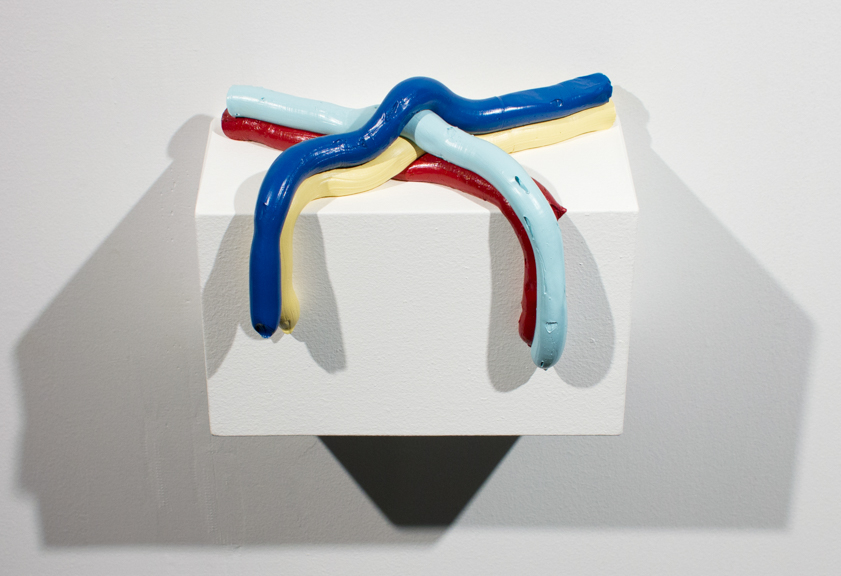Boris Ostrerov
Boris Ostrerov is a painter who manipulates and explores the possibilities and physicality of oil paint. Stacking, gravity, excess, and the confines and edges of the rectangle have been recurring themes in his work for several years. Ostrerov’s current work is seductive, juicy, visceral, and grotesque. He has exhibited widely and has earned several opportunities including showing at Tory Folliard and the Portrait Society in Milwaukee and in Chicago’s NEXT fair. He has been featured in several publications including New American Paintings midwest issue (#119) and the Milwaukee Journal Sentinel. Ostrerov earned a BFA in Painting from the Milwaukee Institute of Art and Design and an MFA in Painting and Drawing at the School of the Art Institute of Chicago in 2013. Upon graduation he was awarded the SAIC fellowship. He currently lives and works in Chicago, IL.
Statement
My thoughts and artistic process tend to push materials and logic to their extremes, to the point where the material or the logic reaches a surprising and absurd conclusion. Stacking, gravity, and the confines or edges of the rectangle have been recurring themes in my work for several years. I think of substrates (and paintings in general) not just as windows but also as literal supports and pedestals for the paint. In some pieces, I use substrates referencing minimalist sculptures only as supports to be decorated with shit-shaped oil paint. I squeeze paint through cake-decorating bags because the process and resulting extrusions are direct and imply urgent libidinal energy, excretion, decoration, commodity, production, the body, and excess. I present a painting language that is very honest to the technique and process, but yields bizarre results. In the new body of work, I introduce painting with brushes and explore the piece as both a support and a window.
Q&A with Boris Ostrerov
By Emily Burns
You graduated from SAIC in 2013, what has the transition out of grad school been like for you? Are you still in Chicago?
Transition was horrible at first, but I learned a lot of things, and everything is coming together much better. In school there was much support, but I didn’t expect it to collapse suddenly. I was caught up in enjoying the utopic environment that is the MFA program and was to busy to realize that you’ll have to work harder after school to make people care about you or your work. Yes I’m still in Chicago and already looking forward to summer.
Can you give us some insight into your process? How do you begin? Do you keep a sketchbook/does drawing play a part in your work?
I keep a sketchbook, but it’s all writing describing ideas for future pieces and diagrams/sketches of paintings/sculptures, so I don’t really “draw.” My process consists of thinking and waiting for an idea to come to my mind, or picking one that I’ve remembered from another day and starting the piece. Sometimes during the making, the idea takes a turn and I end up breaking some of the initial rules and taking the painting where it needs to go. I mix up a bunch of the colors I need to start making the piece and put them into cake decorating bags. Sometimes the idea will change a bit and I’ll mix up more colors but I like to have as much of the tedious mixing ready before I start so that I can maintain a good flow of energy while painting and not get distracted by mixing a ton of paint. Even with a drill, mixing that amount of paint takes a lot of time! I have been taking a lot of breaks where I sit and think about the piece I’m working on or jot notes about an idea for future work, but recently I’ve decided to cut down on time spent thinking that isn’t paralleled by making.
Can you describe your working routine? Do you have a daily studio practice? For you, what is the most important part of maintaining a successful studio practice?
I don’t have a daily studio practice unfortunately. It takes me time to get focused and get in the creative zone, so I like to spend at least 5 hours in the studio at a time if I’m going to be painting. Recently I’ve been starting my studio days by painting watercolors before beginning to work on oil paintings. This helps me get focused, warm up, and helps me to exercise creativity and other issues. I usually listen to rap or dancehall to get in the zone and then turn it off when I’m about to start applying paint. The most important part of maintaining a studio practice is not getting distracted by other shit going on in the world, and leaving instagram to short bathroom breaks only.
In your “Shelf Paintings” you are working with serious amounts of oil paint. What are some of the challenges of working with the material in this way? How long do the pieces take to dry before they can be handled? Are you working with paint from tubes or are you mixing larger batches of paint?
I usually mix particular colors on the pallet. The challenges is that because it takes a long time to mix that amount of paint It presents me with too much time to just stand and think about my next move rather than being more intuitive. Also, the paint takes a long time to dry to the point where I can safely move the piece or add more layers without the paint falling off. This makes it hard for the act of painting to sync up with my inspiration for a painting. It also puts more pressure on each move. I feel this limits my freedom and intuition and in the back of my mind I think that if I fuck up, it will cost me.
Is color an important element in your work? Can you describe your thoughts on color and other formal elements in your work?
In some of the previous pieces I used color to reference color schemes for rooms, and a few famous classical paintings, but feel that I’m not so interested in referencing specific moments from art history as I am in referencing the painting genre itself, or furthermore, more interested in the act and materiality of painting. I am currently thinking about lyric-less music as inspiration for a new long horizontal painting. That type of music reminds me of pure abstraction or just colors and shapes that evoke certain moods or provides specific aesthetic experiences, so I’ll be thinking about how to use color, gesture, and texture to create this painting. Mostly it’ll be hinged around the element of color.
In this long piece I want to make I’m interested in viewers being able to “read” the painting from left to right or right to left, and you can see it in its entirety as well as come closer to only focus on one part at a time.
Are there any artists that you feel your current work is in dialogue with?
Donald Judd and some other minimalists come to mind. In some pieces I was inspired by early minimalist sculptures, which I felt were ripe for some oil paint. Perhaps Jackson Pollock and Lynda Benglis’s pour paintings. Lynda Benglis’s pours on the floor are uncontainable paintings spreading out, and in contrast some of my forms are neat piles of paint carefully stacked on top of each other. I don’t try to specifically reference or respond to other artists, but I share similar interests with Leslie Wayne and Scott Richter’s earlier works. They treat painting like sculpting.
Do you consider your work to always be understood as painting? Do you feel that the work is more powerful when experienced through the lens of the history of painting specifically? Does that matter to you?
I call them paintings because they stemmed from painting and yes, I think they’re more powerful when experienced through the lens of painting history. I see them as both painting and sculpture in one. In the shelf-like pieces I’m poking fun of paintings and minimal sculpture as good supports for paint, which I think requires them to be grounded in the history of painting.
Can you trace any influences in your past that piqued your interest in the canvas as a literal support for a painting and thinking about the confines or edges of the rectangle in this way?
The stretcher became or evolved into a support for paint more so than me searching for a way to make paintings that would showcase themselves as supports for paint. In the past I was trying to break out of the rectangle, maybe stemming from the attitude of going beyond, being excessive, overflowing, thinking about or experiencing suppression and not being able to contain desires, thoughts, or emotions within the body. The urge to spill your guts out, unveil your subconscious, transcend the physical limitations of the body, like the urge to jump 10 ft high, but being 5ft tall translated to more paint, and the piles growing beyond the limits.
More, more, moreeeee.
The action of squeezing out paint from the tube, fighting the resistance of the small opening with your muscles, and out come paint blobs was something I connected to.
I painted abstract paintings where the paint was coming off the edges, and before those I was painting piles of brush-marks on a flat surface. I was interested in calling attention to, or misinterpreting the fundamentals of painting, (one brush-mark on top of the other until it creates an image or finished painting) and this naturally led me to paint onto the top of the rectangular surface and leave some squeezes from the tube on the top stretcher bar. 9 months later I looked at that last painting (I quit that body of work) and it hit me that why not make paintings about just that top part. I enjoy philosophy and am interested in the nihilistic notion that there is no meaning in things so that led me to see paintings in these basic terms, and look at what painting is made up of (physically).
At the same time, I thought that the general public’s impression of minimalism is that it looks boring and dry. I had this image of white blocks or basic shapes sitting on the floor. I thought it would be fun and humorous to decorate them or degrade them by excreting paint onto them and using them as mere pedestals. I like that the forms look cute and beautiful, but the action or gesture used to create those forms recalls shitting, jizzing, and puking.
Can you talk a bit more about your current work with brushes to explore the piece as both a support and a window?
In my recent work, I decided to go back in with brushes alongside the squeezes of paint because I want to bring in more intuition and use of my hand. I’m interested in the piece being both a support for paint and a painting, and also find a way to bring abstract expressionism into the work. Moreover, I am interested in building an object, which can be seen as both a painting and a sculpture. I am trying to set up an interaction between the contained squeezes and the active paint marks created by my hand.
Anything else you would like to share?
Who’s making paintings today that are the equivalent of dubstep?
Good question! I will have to think about that one. Thanks so much for taking the time to share you work and talk with us!
To find out more about Boris and his work, check out his website.













